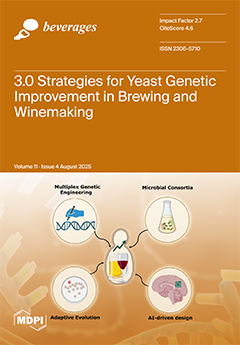Aronia juice is well-known for its high nutritional and biological value, due to its polyphenol content, which has a powerful antioxidant effect. However, the high polyphenol content of aronia juice is associated with an astringent flavor, which diminishes consumer acceptance. To improve the
[...] Read more.
Aronia juice is well-known for its high nutritional and biological value, due to its polyphenol content, which has a powerful antioxidant effect. However, the high polyphenol content of aronia juice is associated with an astringent flavor, which diminishes consumer acceptance. To improve the flavor of aronia juice, β-cyclodextrin (0–2%
w/
v) or gelatin (0–0.4 mg/L) were added before pasteurization. The juice samples were first examined organoleptically, and monitored for total phenolic compounds, antioxidant capacity, total flavonoids, total monomeric anthocyanins, polymeric color, pH, total soluble solids, and color. The organoleptic test demonstrated that both β-cyclodextrin and gelatin juice aroma reduced astringency and increased sweetness, whereas β-cyclodextrin also reduced juice aroma. β-cyclodextrin significantly increased polymeric color and total soluble solids (
p < 0.05), whereas antioxidant activity, total flavonoids, and monomeric anthocyanins remained unchanged compared to the unpasteurized control. In contrast, the addition of gelatin dramatically reduced total phenolic compounds, antioxidant capacity, and total flavonoids, while enhancing polymeric color and maintaining monomeric anthocyanins with minor decreases relative to pre-pasteurization levels (
p < 0.05). A consumer study was conducted with control juice and juices with 2%
w/
v β-cyclodextrin or 0.4 mg/L gelatin added. The results confirmed the change in flavor profile by masking or removing astringency and astringent aftertaste, as well as increasing sweetness, which significantly improved overall acceptability (
p < 0.05).
Full article





